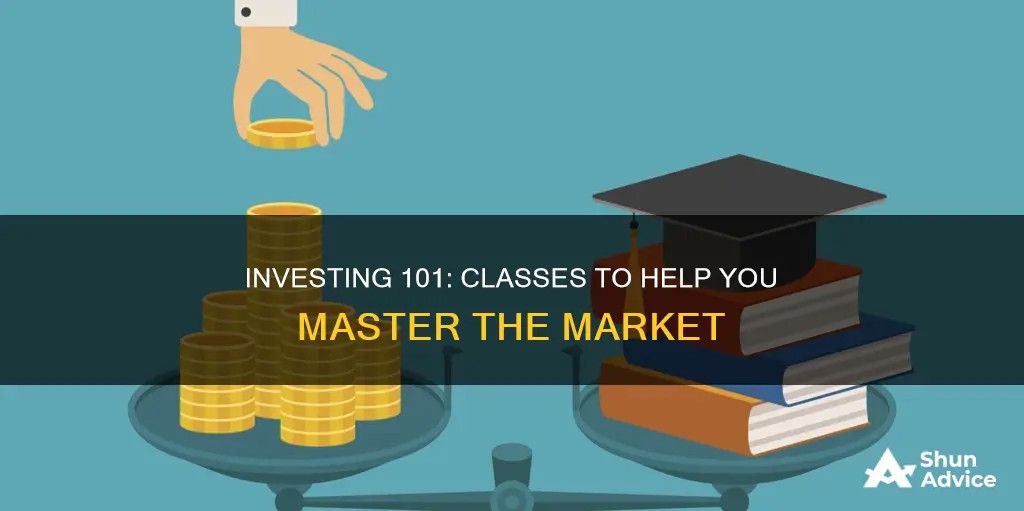
Investing courses are a great way to learn about the stock market and develop skills to grow your wealth. These courses are often affordably priced and accessible to beginning investors. They provide a comprehensive learning experience and introduce students to all aspects of investing, including investment strategies, asset allocation, and portfolio management.
Online platforms such as Coursera, Udemy, and edX offer a range of investment courses for beginners and experienced investors. These courses can help you learn about different types of investments, such as stocks, bonds, real estate, and commodities.
Additionally, broker education centers like E*TRADE and Fidelity offer free investment courses and seminars. Morningstar also provides a free online classroom with courses dedicated to stocks, bonds, funds, and portfolio building.
Investing courses can enhance your critical thinking, analytical, and risk management abilities, opening doors to career opportunities in finance and investment sectors.
| Characteristics | Values |
|---|---|
| Course Provider | Coursera, Udemy, Morningstar, University of Central Florida Online, edX, E*TRADE, Fidelity, Udemy, MIT, Yale, Stanford |
| Course Type | Online, In-Person, Video, Text-Based, Live Webinar, Self-Paced, Self-Led, Interactive, Community-Based, Boot Camp |
| Course Level | Beginner, Intermediate, Advanced |
| Course Topics | Market Basics, Asset Classes, Investment Strategies, Portfolio Management, Risk Assessment, Financial Analysis, Real Estate Investment, Derivatives, Behavioral Finance, Investment Tools, Platforms |
| Course Duration | 1-4 Weeks, 1-3 Months, 3-6 Months, 6 Weeks |
| Course Price | Free, $49, $94.99, $129, $297-$1,547, $3,997, $99-$199/month |
| Course Format | Pre-Recorded Video Lessons, Live Trading Sessions, Text-Based, Trading Simulators, Webinars, Quizzes, Articles, Video Courses, Live Seminars, Lectures, Notes |
What You'll Learn

Investment Risk and the Risk Ladder
The investment risk ladder is a graphical representation of asset categories, with each rung representing a different level of risk. The higher an asset's position on the ladder, the riskier it is. Conversely, the lower an asset is on the ladder, the safer it is, but the lower the potential returns.
Cash
Leaving cash in a bank is virtually risk-free. Investors with cash assets are protected by FDIC insurance, which covers up to $250,000 per depositor per bank. Cash bank deposits are the simplest and most easily understandable investment asset. They provide investors with precise knowledge of the interest they will earn and guarantee the return of their capital.
However, the average interest rate on cash deposits is low, typically around 0.06%. As a result, cash assets may not keep up with inflation, leading to a loss in purchasing power over time. Additionally, investors with a significant amount of cash may miss out on potential returns from riskier asset classes, such as stocks and ETFs.
Fixed Interest Securities (Bonds)
After cash, fixed-interest securities, including bonds and debentures, hold the second-lowest amount of risk on the investment risk ladder. Bonds are considered relatively safe because the chance of the issuer defaulting on their debt obligations is low. For example, U.S. government bonds are viewed as almost risk-free.
While bonds offer a higher return than traditional savings accounts, the returns are typically modest compared to riskier assets. As investors approach retirement, it is common to shift from bonds to stocks to mitigate risk and potentially increase returns.
Mutual Funds
Mutual funds are a type of investment where multiple investors pool their money to purchase a diversified portfolio of stocks, bonds, and other securities. These funds are actively managed by portfolio managers who allocate the fund's assets based on market analysis. Mutual funds offer a long-term return potential of around 4-5%.
While mutual funds provide diversification benefits, they often have higher fees and require a minimum investment, typically between $500 and $5,000. Additionally, mutual funds are usually valued and traded at the end of the trading day, limiting flexibility compared to other investment options.
Exchange-Traded Funds (ETFs)
ETFs are similar to mutual funds in that they enable investors to diversify their portfolios. However, ETFs trade on a stock exchange throughout the day, providing more flexibility and liquidity than mutual funds. ETFs can track various underlying indexes or focus on specific sectors, industries, or asset classes.
Due to their ease of trading and broad coverage, ETFs have become extremely popular with investors. ETFs also tend to have lower fees than mutual funds, making them an attractive option for those seeking diversification and exposure to different markets or sectors.
Shares of Individual Stocks
Individual stocks sit at the top of the investment risk ladder, representing the riskiest asset class. Investing in individual stocks can lead to substantial returns but also carries the possibility of heavy losses. Stock prices can be highly volatile, fluctuating based on various factors such as company performance, market conditions, and news events.
To mitigate the risk associated with individual stocks, investors should diversify their portfolios across different sectors and industries. This diversification ensures that a single stock or sector does not disproportionately impact the overall performance of the portfolio.
In conclusion, the investment risk ladder is a fundamental concept in investing that helps individuals understand the different levels of risk associated with various asset classes. By understanding the risk ladder, investors can make more informed decisions about allocating their capital based on their risk tolerance, investment goals, and time horizon.
The Ultimate Investment: Strategies for Maximum Returns
You may want to see also

Asset Classes
There are five commonly recognised asset classes:
Stocks or Equities
Shares of ownership issued by publicly-traded companies. They are traded on stock exchanges such as the NYSE or NASDAQ. Equities are often subdivided by market capitalization into small-cap, mid-cap, and large-cap stocks.
Bonds or Fixed-Income Investments
Investments in debt securities that pay a rate of return in the form of interest. Such investments are generally considered less risky than investing in equities or other asset classes.
Cash or Cash Equivalents
The primary advantage of cash or cash equivalent investments is their liquidity. Money held in the form of cash or cash equivalents can be easily accessed at any time.
Real Estate or Other Tangible Assets
Real estate and other physical assets are considered an asset class that offers protection against inflation. The tangible nature of such assets also leads to them being considered more "real" than assets that exist only in the form of financial instruments, such as derivatives.
Forex, Futures, and Other Derivatives
This category includes futures contracts, spot and forward foreign exchange, options, and other financial derivatives. Derivatives are financial instruments that are based on, or derived from, an underlying asset. For example, stock options are a derivative of stocks.
Other Asset Classes
Other asset classes include collectibles, hedge funds or private equity investments, and cryptocurrencies such as Bitcoin. These are sometimes classified under the heading of "alternative investments".
Education Patronage: Exploring the Investment vs. Consumption Debate
You may want to see also

Trading vs Investing
Trading vs. Investing
Although the terms "trading" and "investing" are often used interchangeably, they represent distinct approaches to engaging in the financial markets. Both traders and investors seek to profit from market participation, but their strategies, time horizons, and risk profiles differ significantly.
Time Horizon
One of the most significant differences between trading and investing lies in their respective time horizons. Trading typically involves short-term strategies, with traders aiming to generate returns on a daily, monthly, or quarterly basis. In contrast, investing adopts a long-term perspective, often spanning years or even decades, and is commonly associated with retirement accounts.
Risk Profile
The divergent time horizons of trading and investing lead to contrasting risk profiles. Traders are willing to accept higher levels of risk by actively seeking out market fluctuations and aiming to profit from both rising and falling markets. They tend to hold assets for shorter periods and are more open to diverse asset classes, such as futures and swaps. On the other hand, investors usually exhibit a more risk-averse behaviour, opting for a buy-and-hold strategy and riding out short-term losses in anticipation of long-term gains.
Market Approach
Traders and investors also differ in their approach to the market. Traders focus on short-term price movements and technical factors, aiming to exploit small mispricings and market inefficiencies. They require a deep understanding of the markets and consistent monitoring of asset prices. In contrast, investors study a company's long-term growth potential and fundamental factors, such as price-to-earnings ratios and management forecasts.
Profit Expectations
The profit expectations of traders and investors also vary. Traders seek to generate higher returns within shorter time frames and are satisfied with more frequent but smaller profits. In contrast, investors generally aim for larger returns over an extended period, accepting lower annual returns but expecting their investments to grow over time.
Effort Involved
The level of effort and involvement differs between trading and investing. Trading often demands significant time and effort, requiring traders to closely monitor market movements and conduct extensive research. It can become a full-time job due to the frequent transactions and the need to stay abreast of market dynamics. In contrast, investing can be less demanding, adopting a set-it-and-forget-it mentality, especially when investing in diversified funds or a mix of investments.
Asset Classes
Traders and investors may also differ in the types of assets they typically deal with. Traders often trade stocks, commodities, currency pairs, and other instruments, taking advantage of short-term price movements. Investors, on the other hand, tend to focus on a broader range of asset classes, including stocks, mutual funds, bonds, exchange-traded funds (ETFs), and other investment instruments, holding these assets for the long term.
Ratios Reveal: Investing Insights
You may want to see also

Investment Strategies
Diversification
Diversifying your investment portfolio across different asset classes is a common strategy to manage risk and maximise returns. This involves investing in a range of assets such as stocks, bonds, real estate, commodities, and more. By diversifying, investors can reduce the impact of losses in one asset class and benefit from the gains in others.
Long-Term Investing
Long-term investing, or buy-and-hold strategy, involves purchasing assets with the intention of holding them for an extended period, often several years or decades. This strategy aims to ride out the short-term market volatility and capture the long-term growth potential of the assets. It also helps reduce the impact of short-term costs like transaction fees.
Dollar-Cost Averaging
Dollar-cost averaging (DCA) is an investment strategy where an individual invests a fixed amount of money in a particular asset or portfolio of assets at regular intervals, such as monthly or quarterly. This strategy helps mitigate the risk of investing a large sum at an inopportune time, as it averages out the purchase price over time.
Value Investing
Value investing involves identifying and investing in assets that appear to be trading for less than their intrinsic value. This strategy requires analysing financial statements, evaluating the management's decisions, and considering the economic environment to determine if an asset is undervalued. Value investors aim to profit by buying these assets at a discount and selling them when they believe they reach their fair value.
Growth Investing
Growth investing focuses on investing in companies that are expected to experience above-average growth in revenue and earnings compared to their industry peers. These companies typically reinvest their profits to fuel further growth instead of paying dividends. Growth investors aim to benefit from the potential increase in the value of these companies over time.
Index Investing
Index investing involves purchasing a basket of assets designed to track a specific market index, such as the S&P 500 or the Dow Jones Industrial Average. By investing in an index fund, individuals gain exposure to a diversified portfolio of assets that mirror the performance of the underlying index. This strategy offers broad market coverage and is often considered a more passive approach to investing.
Retirement Investing: Navigating the Golden Years with Financial Confidence
You may want to see also

Financial Markets
This course, taught by Professor Robert Shiller, offers an in-depth exploration of financial markets, insurance, and the Capital Asset Pricing Model (CAPM). It is designed to provide a strong foundation in these areas and emphasizes the development of financially-savvy leadership skills. The course is structured into seven modules, covering a range of topics, including risk management, behavioural finance, securities, and banking industries. It also delves into stocks, bonds, dividends, shares, market caps, and corporate basics. With 33 hours of content and no prior experience required, this course is a comprehensive introduction to financial markets.
Investment Management by University of Geneva (Coursera)
The Investment Management course offered by the University of Geneva is a beginner-level specialization that can be completed in 3 to 6 months. It provides an introduction to finance and investment management, covering topics such as financial analysis, risk management, and market analysis. The course also touches on behavioural economics and leadership and management skills.
Investment and Portfolio Management by Rice University (Coursera)
Rice University's Investment and Portfolio Management course is another beginner-level option that can be completed in 3 to 6 months. It focuses on teaching students about investment strategies, asset allocation, and portfolio management. The course covers a range of topics, including financial analysis, risk assessment, and financial markets.
Financing and Investing in Infrastructure by Università Bocconi (Coursera)
This course by Università Bocconi takes a practical approach to financing and investing in infrastructure. It covers topics such as financial analysis, investment management, project management, and contract management. The course is designed for those interested in infrastructure financing and provides a solid foundation in financial management and analysis.
Alternative Investments by Harvard Business School (Harvard Business School Online)
Harvard Business School's Alternative Investments course helps students develop their ability to evaluate potential investment opportunities and maximize the value of portfolios. It covers various types of alternative investments, including real estate, private equity, and venture capital. The course also addresses evaluating environmental, social, and governance (ESG) factors for impact investments.
These courses offer a comprehensive understanding of financial markets and their role in investing. They cover a range of topics, from basic financial market principles to more specialized areas, providing a strong foundation for those interested in investing.
Who Really Knows How to Invest?
You may want to see also
Frequently asked questions
Equities, fixed-income securities, and cash equivalents. Other asset classes include derivatives, commodities, real estate, and alternative assets.
Udemy, Coursera, edX, and Morningstar all offer investment courses.
Morningstar's Investing Classroom, Udemy's Stock Market From Scratch for Complete Beginners, and University of Central Florida's Stocks, Bonds, and Investing: Oh, My! are all good options for beginners.
Advanced learners can consider courses on specific investment areas like real estate, derivatives, or preparing for certifications such as CFA (Chartered Financial Analyst).







